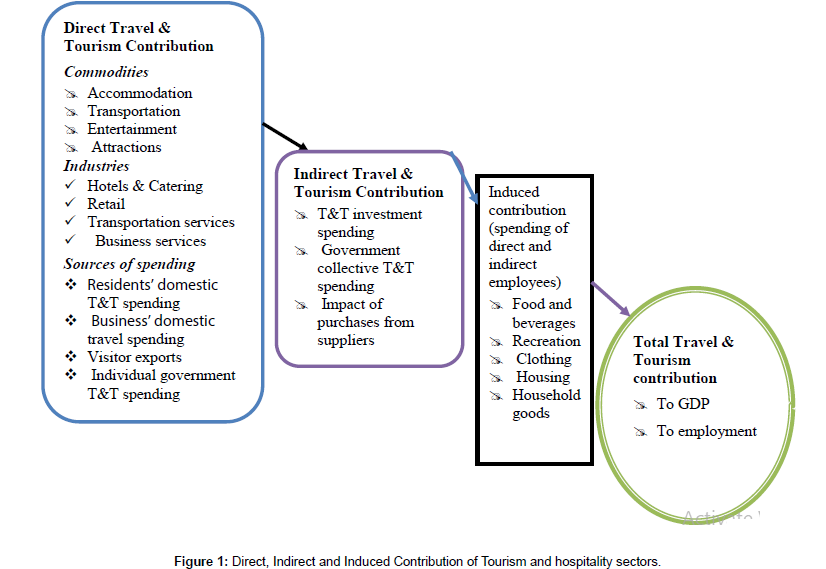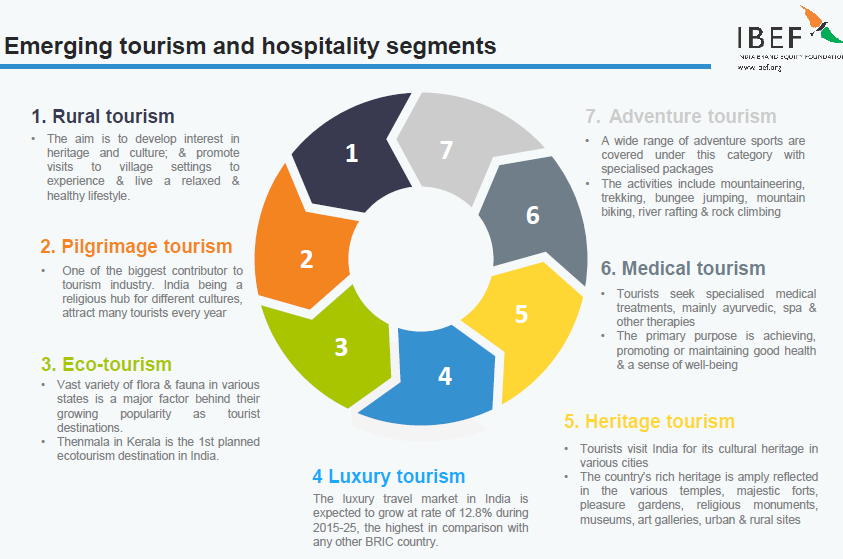Tourism and Hospitality Industry in India
2023 JAN 12
Mains >
Economic Development > Indian Economy and issues > Tourism
IN NEWS:
- After struggling for over two years due to COVID-19-induced restrictions, the tourism and hospitality industry is showing signs of a strong revival.
WHAT IS THE TOURISM AND HOSPITALITY INDUSTRY?
- The tourism and hospitality industry is a vast sector that includes all the economic activities that directly or indirectly contribute to, or depend upon, travel and tourism.
- The hospitality and tourism industry has four service sectors:
- Food and beverage
- Lodging
- Recreation
- Travel and tourism
STATISTICS:
- By 2028, Indian tourism and hospitality industry is expected to earn 50.9 billion dollar as compared with 28.9 billion dollar in 2018.
- The travel market in India is projected to reach 125 billion dollars by FY27, up from an estimated 75 billion dollars in FY20.
- During 2019, contribution of travel & tourism to GDP was 6.8% of the total economy, about Rs. 13, 68, 100 crore.
- According to World Travel & Tourism Council (WTTC) India ranked 10th among 185 countries in terms of travel & tourism’s total contribution to GDP in 2019.
INDIA'S OPPORTUNITIES IN THE HOSPITALITY AND TOURISM INDUSTRY:
- Robust demand:
- By 2029 India’s tourism sector is expected to grow 6.9% to reach 35 trillion rupees and accounting for 9.2% of total economy.
- International tourist arrival in India is expected to reach 30 million by 2028
- Fast pace of digitalization:
- India is the most digitally advanced traveller nation in terms of digital tools being used for planning, booking, and experiencing a journey.
- Burgeoning middle class:
- India’s rising middle class and increasing disposable income has supported the growth of domestic and outbound tourism.
- Role of MNCs:
- International hotel chains are increasing their presence in the country, and it will account for around 50% share in the tourism and hospitality sector of India by 2022.
- Better and sustainable economy:
- As tourism and hospitality industry is a part of service industry and Indian economy is transferring very rapidly from manufacturing to service centered economy system, it could contribute a lot due to its advantages like increase in foreign tourist arrivals, additional foreign exchange earnings from tourism and employment generation/ manpower requirement.
- By 2029, tourism and hospitality industry is expected to account for about 53 million jobs.
- In 2021, foreign exchange earnings from tourism industry across India amounted to nearly nine billion U.S. dollars. This was a rise of over 26 percent compared to the previous year.
- In 2019, tourism was the third largest foreign exchange earner for the country.
------------------------------
- Large investment inflow:
- India was globally the third largest in terms of investment in travel and tourism with an inflow of US$ 45.7 billion in 2018, accounting for 5.9% of the total investment in the country.
- Hotel and Tourism sector received cumulative FDI inflow of USD 15.61 billion between April 2000 and December 2020.
- Policy support:
- Campaigns such as Swadesh Darshan, a theme based tourist circuit was launched to harness the tourism industry’s potential.
- Also, in the Union Budget 2022-23, Rs. 2,400 crore has been allocated to the Ministry of Tourism which is 18.42% higher than the allocation for FY 2021-22.
- G20 summit 2023:
- As India takes on the G20 presidency and starts preparing for the summit in 2023, the government can work together with the tourism and hospitality industry to position the country as a safe, tourist-friendly destination by providing world-class experiences to visiting dignitaries.
- Around 300 plus meetings are expected to take place during the summit, most of which will be hosted within the corridors of the finest hotels across the country.
- Using the summit to highlight the country’s unique and differentiated travel offerings, India can claim its position on the world tourism stage.
- Diverse attractions:
- India offers geographical diversities, cultural richness, numerous local traditions like art forms, dances etc.
- Medical tourism:
- India’s low-cost healthcare facilities with the presence of quality healthcare specialists along with the AYUSH system of medicine make the country a good destination for medical treatments.
--------------------
CHALLENGES:
- Skill gap:
- The number of adequately trained individuals for the tourism and hospitality sector is a key challenge to giving visitors a world-class experience.
- A limited number of multi-lingual trained guides and the limited local awareness and understanding of the benefits and responsibilities associated with tourist growth act as constraints on the sector’s growth.
- Infrastructural constraints:
- Deficiencies in infrastructure and inadequate connectivity hamper tourist visits to some heritage sites.
- Also, India has various tourist destinations but few circuits or segments such as the Golden Triangle (Delhi-Agra-Jaipur).
- Inadequate marketing:
- Although it has been increasing, online marketing/branding remains limited and campaigns are not coordinated.
- Higher lending rate:
- RBI has equated the hotel sector with real estate and this leads to lending at a high interest rate from banks.
- Thus CII suggested the hotel industry be granted ‘infrastructure’ status.
- Safety concerns:
- Several tourists are concerned about safety issues, especially in remote rural areas where enforcing law and order may be faced with much more challenges.
- Fluctuation in Demand & Supply:
- Fluctuating demand and supply, as well as off-season, are major challenges in the tourism and hospitality industry.
- Competition:
- New arrivals in this sector from domestic market and global market make this sector very competitive, which ultimately create huge competition.
- Pandemic:
- The tourism and hospitality industries have been particularly hard hit by the COVID-19 pandemic, bearing the brunt of lockdowns and social isolation.
- According to the UN World Tourism Organization (UNWTO), this is by far the worst crisis international tourism has faced since records began in 1950.
MAJOR GOVERNMENT INITIATIVES:
- Improving connectivity and infrastructure:
- Swadesh Darshan Scheme:
- It aims to develop theme-based tourist circuits in the country.
- Pilgrimage Rejuvenation and Spiritual Augmentation Drive (PRASAD):
- It focuses on identifying and developing the pilgrim sites across the country to enrich the religious tourism experience.
- National Integrated Database of Hospitality Industry (NIDHI):
- It will serve as a common repository of data from Ministry of Tourism, State Departments of Tourism and Industry and enable the Central and State Governments to deliver better support and services including policies and strategies.
- ‘Adopt a Heritage’ Scheme:
- It aims to involve public sector companies, private sector companies, and corporate citizens/individuals to take up the responsibility for making our heritage and tourism more sustainable.
- Tourist helpline:
- Launch of 24x7 toll free multi-lingual tourist helpline in 12 International languages including Hindi and English.
- Other major initiatives to improve connectivity and infrastructure:
- Regional Connectivity Scheme – UDAN
- Viability Gap Scheme for Revenue Generating Tourism Projects
- Iconic Tourist Destinations Scheme
- Improving foreign tourist arrivals:
- E-visa:
- At present the e-Visa Scheme is available to nationals of 169 countries
- e-Visa is valid for entry through 28 designated Airports and 5 designated seaports
- Incredible India campaign:
- Launch of the Incredible India 2.0 campaign with market specific promotional plans and content creation.
- Incredible India Website launched in Chinese, Arabic and Spanish languages to attract tourists from these regions.
- India Tourism offices abroad:
- Promotional activities in tourist generating markets overseas through the India Tourism Offices abroad with active participation in travel fairs and exhibitions
- Cultural connect:
- Organization of biennial International Buddhist Conclave.
- Project Mausam is a cultural and economic project by the Ministry of Culture and ASI which aims to connect countries on the Indian Ocean
- International Day of Yoga
- Skilling:
- Incredible India Tourist Facilitator (IITF) Certification Programme
- It is a Pan-India online learning program accessible from different digital devices.
- The programme aims at enhancing the overall experience of tourists by creating a pool of local, trained professionals
- Other initiatives:
- ‘Dekho Apna Desh’ initiative
- Ek Bharat, Shreshtha Bharat
WAY FORWARD:
- Tap the potential of rural tourism:
- Improved infrastructure and connectivity of rural India can improve rural tourism.
- ‘One India One Tourism’ Approach:
- Tourism encompasses multiple ministries and takes place in and within states. It thus requires a National Tourism Council, an empowered legislative body that will enable fast-tracking of Centre-state level tourism matters and will create a ‘One India One Tourism’ approach.
- Bring tourism in the concurrent list:
- Confederation of Indian Industry (CII) has sought the inclusion of tourism in the concurrent list to enable the Centre and States to effectively regulate the sector as well as frame policies for growth.
- Provide ‘Infrastructure status’ to the hotel industry:
- Confederation of Indian Industry (CII) suggest that the hotel sector be delinked from real estate and also be granted infrastructure status under Income Tax Act
- Promotion of Niche tourism:
- Identification of strengths of villages in different states and introduction of customised trips like Tribal tours in North-East India, cultural and heritage walk in Rajasthan
- Capacity building at grass root level:
- Adequate finances must be devolved to the gram sabha for maintenance of basic infrastructure.
- Training of villagers to guide and assists tourists.
- Promote sustainable and responsible tourism:
- Ecological impact of increased number of tourists must be assessed.
|
Case study:
Responsible Tourism (RT) Mission
- Responsible Tourism (RT) Mission is the nodal agency formed by the Government of Kerala to spread and implement the ideologies and initiatives of responsible tourism all over the State. It was launched on 20th October 2017.
- The Mission is envisaged with a 'triple-bottom-line' mission, which comprises economic, social and environmental responsibilities.
- Making tourism a tool for the development of village and local communities, eradicating poverty and giving emphasis to women empowerment are the main aims of the Responsible Tourism Mission.
- The mission aspires to provide an additional income and a better livelihood to farmers, traditional artisans, and marginalised people along with creating a social and environmental equilibrium.
|
PRACTICE QUESTION:
Q. “The Indian tourism and hospitality industry have emerged as one of the key drivers of growth among the services sector in India”. Discuss.

